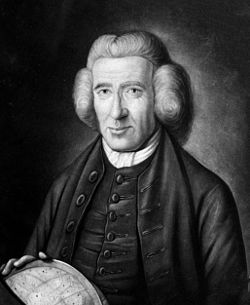James Ferguson (Scottish astronomer)

James Ferguson (25 April 1710 – 17 November 1776) was a
Biography
Ferguson was born near
His taste for mechanics was about this time accidentally awakened on seeing his father making use of a

In 1734 he went to
In 1748, Ferguson began to give public lectures on experimental philosophy, which he repeated in most of the principal towns in England. During his time traveling in England, the well known London bookseller Andrew Millar arranged lectures for him in the spa towns of Royal Tunbridge Wells and Bath.[7] Ferguson's deep interest in his subject, his clear explanations, his ingeniously constructed diagrams, and his mechanical apparatus rendered him one of the most successful of popular lecturers on scientific subjects.[2]
As the inventor and improver of astronomical and other scientific apparatus, and as a striking instance of
During the latter years of his life he received a pension of £50 from the
Legacy
Although not as well known nowadays, Ferguson was widely influential in his own time. Thomas Paine mentioned him in his publication "The Age of Reason" and William Herschel studied astronomy from his books.[8] His international reputation was such that he was elected to the American Philosophical Society in 1770.[9] The German experimental physicist Georg Christoph Lichtenberg admired Ferguson: "Everything was done by experiments – he had not even chalk and sponge."[10][11]
Works


Ferguson's principal publications are:
- Astronomical Tables (1763)
- Lectures on Select Subjects (first edition, 1760, edited by Sir David Brewster in 1805)
- Astronomy explained upon Sir Isaac Newton's Principles (1756, edited by Sir David Brewster in 1811)
- Astronomy explained upon Sir Isaac Newton's Principles. London: Andrew Millar. 1764.
- Select Mechanical Exercises, with a Short Account of the Life of the Author, written by himself (1773).
- Introduction to Electricity (First Edition 1770; Second Edition 1775; (1778)).[12]
His autobiography is included in the 1857 biographical dictionary of eminent Scotsmen[13] and in Life by E. Henderson, LL.D. (first edition, 1867; 2nd, 1870), which also contains a full description of Ferguson's principal inventions, accompanied with illustrations.
-
1757 copy of Ferguson's "Astronomy Explained upon Sir Isaac Newton's Principles and Made Easy for Those Who Have Not Studied Mathematics"
-
Table of contents for "Astronomy Explained upon Sir Isaac Newton's Principles and Made Easy for Those Who Have Not Studied Mathematics"
-
Table from "Astronomy Explained upon Sir Isaac Newton's Principles and Made Easy for Those Who Have Not Studied Mathematics"
-
Table from "Astronomy Explained upon Sir Isaac Newton's Principles and Made Easy for Those Who Have Not Studied Mathematics"
Further reading
- Laudan, Laurens (1970–1980). "Ferguson, James". ISBN 978-0-684-10114-9.
- The Story of the Peasant-Boy Philosopher, by Henry Mayhew (1857).
- "Wheelwright of the Heavens" by John R. Millburn (In collaboration with Henry C. King) 1988. A revised biography based on Hendersons "Life" but with much additional research.
References
- ^ . Dictionary of National Biography. London: Smith, Elder & Co. 1885–1900.
- ^ a b c d e f Chisholm 1911.
- ISBN 978-0-387-31022-0. Retrieved 22 August 2012.
- ^ A Philosopher Lecturing on the Orrery (1764-1766), Revolutionary Players, image from Derby Museum and Art Gallery, Derby, accessed March 2011
- The Royal Society. Retrieved 30 July 2011.
- ^ George Glazer James Ferguson www.georgeglazer.com, n.d., retrieved January 2017
- ^ "The manuscripts, Letter from Andrew Millar to Andrew Mitchell, 26 August, 1766. See footnote no. 36". www.millar-project.ed.ac.uk. Retrieved 1 June 2016.
- ^ James Ferguson (1710-1776) Famous sons of Rothiemay, district of Rothiemay, n.d., retrieved January 10, 2017
- ^ "APS Member History". search.amphilsoc.org.
- ^ Unpublished manuscript of a university lecture. Cited from Schöne A. (1982), Aufklärung aus dem Geist der Experimentalphysik. Lichtenbergsche Konjunktive, München: Beck, 1982, p.52
- ^ Hochadel, O. (1998), "Martinus Electrophorus Berschütz. G.Ch.L. und die wissenschaftlichen Schausteller seiner Zeit", Lichtenberg-Jahrbuch, 1998, p 18.
- ^ Ferguson, James (1778). An introduction to electricity. In six sections ... Francis A. Countway Library of Medicine. London : Printed for W. Strahan, and T. Cadell, in the Strand.
- ^ James Ferguson A biographical dictionary of eminent Scotsmen, 3, edited by Robert Chambers and Thomas Napier Thomson, 1857, Blackie and Son, Glasgow
- This article incorporates text from a publication now in the public domain: Chisholm, Hugh, ed. (1911). "Ferguson, James". Encyclopædia Britannica. Vol. 10 (11th ed.). Cambridge University Press. p. 272.
External links
- Philosophy of Science Portal
- George Glazer Gallery
- Texts by James Ferguson on the Internet Archive (see all):
- Astronomy explained upon Sir Isaac Newton's Principles ... (2nd American edition, 1809)
- Select mechanical exercises: shewing how to construct different clocks, orreries, and sun-dials ...: to which is prefixed, a short account of the life of the author (1773)
- An easy introduction to astronomy for young gentlemen and ladies ... (2nd American edition, 1812)
- An introduction to electricity. In six sections ... (3rd ed., 1778)
- Lectures on select subjects in mechanics, hydrostatics, pneumatics, optics, and astronomy (1839 ed.)
- Tables and tracts, relative to several arts and sciences (2nd ed., 1771)




